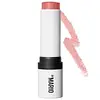What's inside
What's inside
 Key Ingredients
Key Ingredients

 Benefits
Benefits

No benefits
 Concerns
Concerns

 Ingredients Side-by-side
Ingredients Side-by-side

Diisostearyl Malate
EmollientOctyldodecanol
EmollientPolyglyceryl-3 Diisostearate
EmulsifyingPolyethylene
AbrasiveMica
Cosmetic ColorantMicrocrystalline Wax
Emulsion StabilisingHydrogenated Microcrystalline Wax
Emulsion StabilisingSynthetic Wax
AbrasivePentaerythrityl Tetra-Di-T-Butyl Hydroxyhydrocinnamate
AntioxidantDicalcium Phosphate
AbrasiveTin Oxide
AbrasiveCI 77891
Cosmetic ColorantCI 77492
Cosmetic ColorantCI 15850
Cosmetic ColorantOctyldodecanol
EmollientHydrogenated Polyisobutene
EmollientHydrogenated Poly(C6-14 Olefin)
EmollientPolyethylene
AbrasiveSilica
AbrasiveDiisostearyl Malate
EmollientSynthetic Wax
AbrasiveSynthetic Fluorphlogopite
Sorbitan Isostearate
EmulsifyingEthylene/Propylene Copolymer
AbrasiveCera Microcristallina
Emulsion StabilisingTocopherol
AntioxidantMethicone
EmollientTriethoxycaprylylsilane
BHT
AntioxidantCI 77891
Cosmetic ColorantCI 77492
Cosmetic ColorantCI 15850
Cosmetic ColorantCI 19140
Cosmetic ColorantOctyldodecanol, Hydrogenated Polyisobutene, Hydrogenated Poly(C6-14 Olefin), Polyethylene, Silica, Diisostearyl Malate, Synthetic Wax, Synthetic Fluorphlogopite, Sorbitan Isostearate, Ethylene/Propylene Copolymer, Cera Microcristallina, Tocopherol, Methicone, Triethoxycaprylylsilane, BHT, CI 77891, CI 77492, CI 15850, CI 19140
 Reviews
Reviews

Ingredients Explained
These ingredients are found in both products.
Ingredients higher up in an ingredient list are typically present in a larger amount.
Ci 15850 is the pigment color red. It is an azo dye and created synthetically.
Azo dyes need to be thoroughly purified before use. This allows them to be more stable and longer-lasting.
This ingredient is common in foundations, lipsticks, and blushes. This color is described as brown/orangey red.
It has many secondary names such as Red 6 and Red 7. According to a manufacturer, Red 6 usually contains aluminum.
Learn more about CI 15850Ci 77492 is also hydrated iron III oxide. It's sole purpose is to give a yellow hue to products.
Iron III oxides are classified as inorganic chemicals for coloring.
Synthetically created Ci 77492 is considered safer than those naturally found. This is because the synthetically created version may contain less impurities. Iron oxides are generally non-toxic and non-allergenic.
Learn more about CI 77492Ci 77891 is a white pigment from Titanium dioxide. It is naturally found in minerals such as rutile and ilmenite.
It's main function is to add a white color to cosmetics. It can also be mixed with other colors to create different shades.
Ci 77891 is commonly found in sunscreens due to its ability to block UV rays.
Learn more about CI 77891Diisostearyl Malate is an emollient and most often used in lip products. It comes from isostearyl alcohol, a fatty acid, and malic acid, an AHA.
As an emollient, Diisostearyl Malate helps create a thin film on your skin to trap moisture in. This helps keep your skin soft and smooth.
Octyldodecanol is a fatty alcohol. It is primarily used to enhance the texture of products.
As an emulsifier, Octyldodecanol helps prevent the oils and waters from separating. It also prevents ingredients from creating foam when shaken.
Octyldodecanol is created by reducing fatty acid to an alcohol.
Due to its high molecular weight, it does not get absorbed into the skin.
Learn more about OctyldodecanolPolyethylene is a synthetic ingredient that helps the skin retain moisture. It is a polymer.
It is also typically used within product formulations to help bind solid ingredients together and thicken oil-based ingredients. When added to balms and emulsions, it helps increase the melting point temperature.
Synthetic Wax is created from fossil fuels such as natural gas. It is used to enhance texture, adjust pH, and as an occlusive.
It may also be used as an abrasive ingredient to exfoliate the skin.
Synthetic Wax may not be fungal acne safe.
Learn more about Synthetic Wax